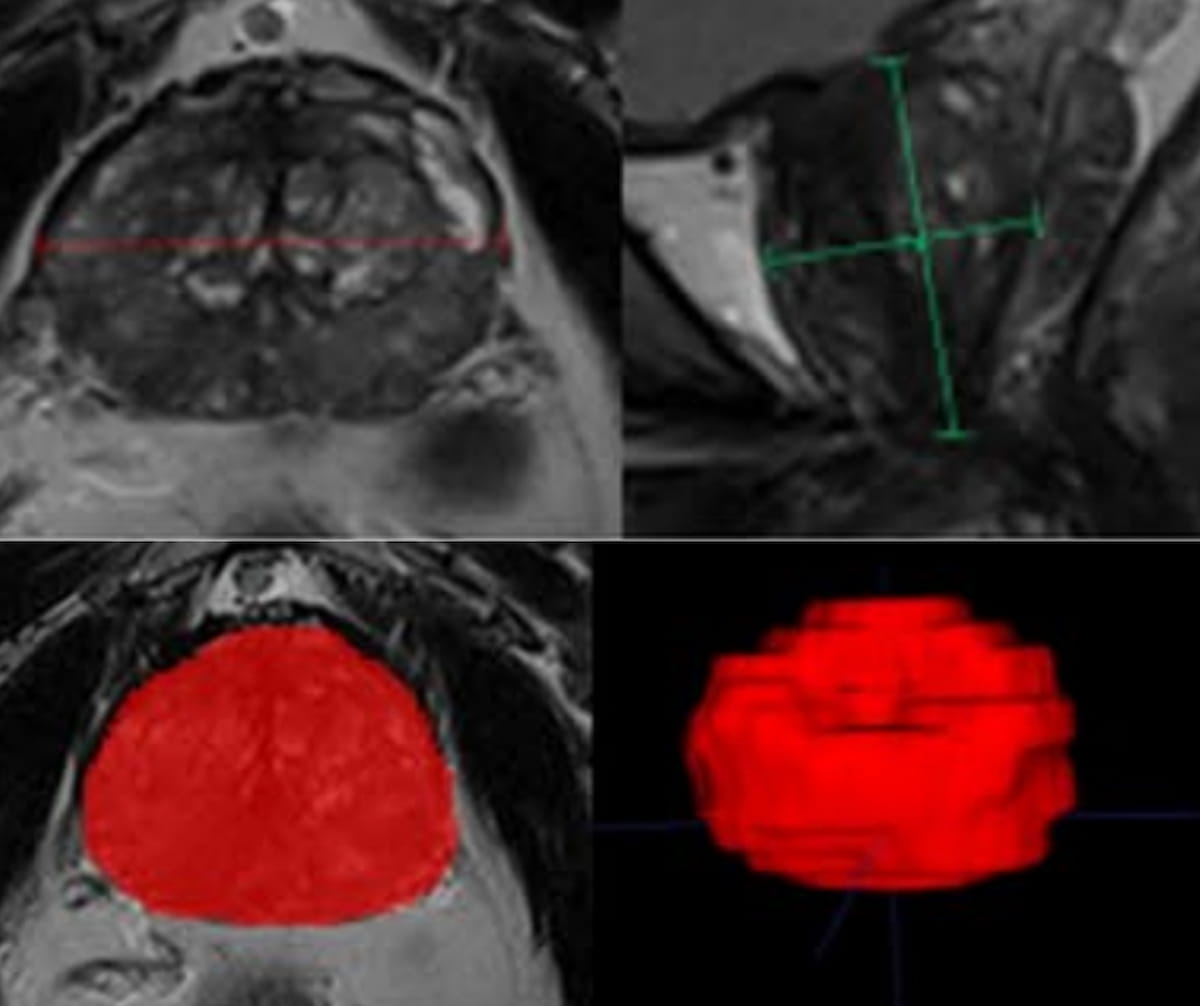Study Shows Benefits of AI for Prostate Cancer Detection on Multiparametric MRI
The use of adjunctive artificial intelligence (AI) reportedly improved lesion level sensitivity by nearly 19 percent and patient level specificity by 14 percent for the diagnosis of clinically significant prostate cancer on multiparametric magnetic resonance imaging (MRI).
Adjunctive artificial intelligence (AI) may result in improved sensitivity and specificity in the assessment of clinically significant prostate cancer (csPCa) on multiparametric magnetic resonance imaging (mpMRI), according to newly published research.
For the retrospective multicenter study, recently published in Insights into Imaging, researchers examined the impact of a deep learning-based AI software upon 16 radiologists reviewing mpMRI scans for csPCa.1 (The study authors noted that the radiologist experience with interpretation of mpMRI ranged from one to five years.) Out of 480 mpMRI images, 180 cases revealed a total of 349 csPCa lesions, according to the study. The study authors noted that each radiologist diagnosed 30 cases twice, one time with AI and one time without AI with a four-week interval between the reviews.
For csPCa lesion level sensitivity, researchers noted an increase from 40.1 percent without AI to 59 percent with AI. Adjunctive AI also led to a 14 percent increase (from 57.7 percent to 71.7 percent) in patient level specificity for csPCa while maintaining sensitivity (88.3 percent without AI to 93.9 percent with AI), according to the study authors.1
“The results showed that AI software substantially improved the lesion-level and patient-level specificity of the readers while preserving patient-level sensitivity in detecting MRI-visible csPCa,” wrote study co-author Xiaoying Wang, M.D., Ph.D., who is affiliated with the Department of Radiology at Peking University First Hospital in Beijing, China, and colleagues.
Images courtesy of Insights into Imaging.

(Editor’s note: For related content, see “Can Explainable AI Enhance Diagnosis and PI-RADS Classification of Prostate Cancer on MRI?,” “FDA Clears RadNet’s Updated AI Software for Prostate MRI” and “Can an Emerging PSMA/PET Agent Improve Detection of Prostate Cancer Recurrence in Patients with Low PSAs?”)
The researchers also found that adjunctive AI had a 21.7 percent higher accuracy rate in identifying true positive lesions (68.2 percent) in comparison to 46.5 percent for radiologist assessment without AI. For true-positive patient diagnosis, the study authors noted that adjunctive AI had a 66.1 percent detection rate in comparison to 55.8 percent for radiologists without AI.1
Citing research that demonstrates the ability of radiologists to detect large prostate lesions without AI assistance, Wang and colleagues said they excluded cases involving prominent lesions and advanced cancer.2 While they noted this may have contributed to underestimation of radiologist assessment without AI, the researchers emphasize this also conveys the ability of the AI software to assist in diagnosing more challenging presentations of prostate cancer.
“Our findings suggest that the ability of radiologists to detect difficult lesions was significantly improved with the help of AI. Given the significant improvement in the detection of MRI-visible csPCa lesions (with adjunctive AI), the AI-aided results have greater value in guiding the localization of biopsy,” maintained Wang and colleagues.
Beyond the inherent limitations of a retrospective study, the authors acknowledged the potential for bias with annotations from a reference standard based on cognitive fusion biopsy. They also noted challenges with stratification analysis due to wide variety in the experiences of the reviewing radiologists.
References
1. Sun Z, Wang K, Kong Z, et al. A multicenter study of artificial intelligence-aided software for detecting visible clinically significant prostate cancer on mpMRI. Insights Imaging. 2023 Apr 30;14(1):72. doi: 10.1186/s13244-023-01421-w.
2. Zhu L, Gao G, Liu Y, et al. Feasibility of integrating computer-aided diagnosis with structured reports of prostate multiparametric MRI. Clin Imaging. 2020;60(1):123-130.
Meta-Analysis Shows No Difference Between bpMRI and mpMRI in Ruling Out csPCa
March 6th 2025In an 18-study meta-analysis involving over 4,600 patients, researchers found that bpMRI and mpMRI had equivalent pooled negative predictive value (NPV) of 92 percent for clinically significant prostate cancer (csPCa).
Can Deep Learning Ultra-Fast bpMRI Have an Impact in Prostate Cancer Imaging?
March 3rd 2025A deep learning-enhanced ultra-fast bpMRI protocol offered similar sensitivity for csPCa as mpMRI with an 80 percent reduction in scan time, according to research findings presented at the European Congress of Radiology (ECR) conference.
Emerging AI Software for Prostate MRI Offers 95 Percent Sensitivity for csPCa
February 28th 2025In a multicenter study involving over 1,000 patients, a deep learning software offered comparable sensitivity and specificity for Gleason grade group > 2 tumors in comparison to radiologist interpretation.
Can CT-Based AI Help Predict Renal Function Decline After Radioligand Therapy for mCRPC?
February 25th 2025In patients who had at least four cycles of 177Lu-PSMA-I&T for mCRPC, new research shows that a 10 percent or greater decrease in total kidney volume on CT at six months has a 90 percent AUC for predicting estimated glomerular filtration rates (eGFRs) of 30 percent or greater at one year.